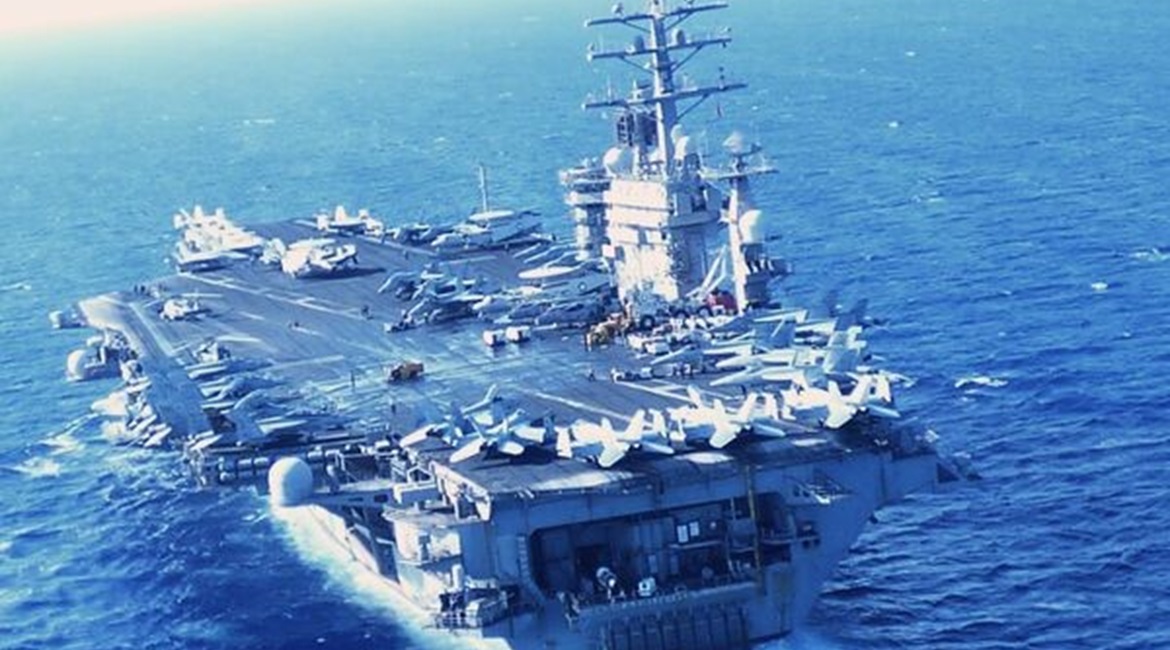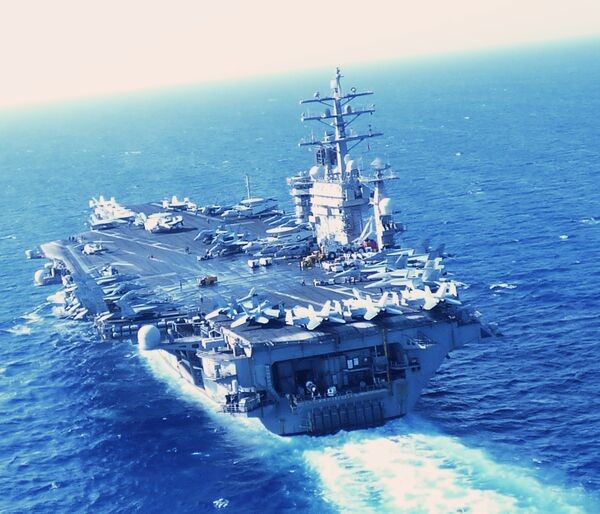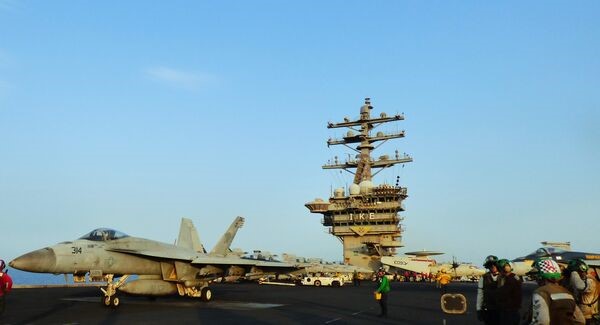
Date Posted: 28-Jun-2024
Key points
- The US Navy's Eisenhower CSG has been involved in Red Sea maritime security operations since late 2023
- Carrier aviation and escort vessels have had to modify sensors, platforms, and TTPs in response to counter rapidly evolving missile and unmanned threats
A US carrier strike group (CSG) traditionally enters a geopolitically tense region with the intention to assert presence and project a sense of security. However, the mission of CSG 2, anchored around aircraft carrier USS Dwight D Eisenhower (CVN 69), quickly morphed into one of maritime combat.
“I did not expect [to] be in [the] Red Sea dealing with [the] Houthis,” Captain Marvin Scott, Eisenhower commander of the air group (CAG), told Janes on 12 June in an interview aboard the carrier in the Red Sea, days before the ship moved out of the combat zone.

USS Dwight D Eisenhower and its strike group were redirected to the Red Sea to provide enhanced security. (Janes/Michael Fabey)
“In October we knew what Hamas had done in Israel and I thought we'd play more of a presence role,” he said.
Indeed, when Eisenhower left for its regularly scheduled deployment to the US European Command (EUCOM) area of responsibility (AOR) on 14 October, the ship and CSG were expected to complete a mostly European and Mediterranean tour, making port calls in the region and conducting operations with allies and partners.
“Initially, we were looking [to] spend our time with the 5th Fleet AOR, primarily in EUCOM,” Capt Sott said.
Captain Chris Hill, Eisenhower commanding officer, told Janes during an 11 June interview aboard his ship, “About the time we came back down to the Gulf, the Houthis started their attacks on merchant vessels. We did not expect this.”
Deployment shift
The Pentagon on 21 October confirmed a shift of CSG 2 ships to the Central Command (CENTCOM) AOR and deployed a Terminal High Altitude Area Defense (THAAD) battery, as well as additional Patriot battalions to locations throughout the region to increase force protection for US forces.
In a statement at the time, US Secretary of Defense Lloyd Austin said the shift came after “detailed discussions with [US] President [Joe] Biden on recent escalations by Iran and its proxy forces across the Middle East region … to further strengthen the Department of Defense's posture in the region … and assist in the defence of Israel”.
Capt Hill said, “We ended up in [the] Red Sea in [a] fistfight with [the] Houthis.”
A “fistfight” of this nature involving a carrier is something some naval strategists and analysts have warned about – even dreaded – in recent years, particularly given the increasing use of ballistic missiles and threats such as unmanned aerial vehicles (UAVs), unmanned surface vehicles (USVs), and unmanned underwater vehicles (UUVs), which have been presented as a potential Achilles' heel for carriers and their escort ships over the past decade or so.
Particularly bleak scenarios were painted for older carriers like Eisenhower, which lacked the raft of new technologies meant to make the newer Ford-class carriers more relevant and survivable.
However, Eisenhower and its accompanying guided-missile destroyers (DDGs) have met Red Sea combat needs, intercepting and destroying missiles and unmanned attacks, mounted against US Navy (USN) ships and merchant vessels and land facilities.
The ships provided such a defence shield by modifying sensors; systems; and tactics, techniques, and procedures (TTPs), adapting to Houthi methods, strike group officers told Janes.
Those modifications came from real-time analysis not only by naval strategists on the scene but also by engineers, scientists, and operational experts back in the United States.
For example, after DDGs proved adept at intercepting UAVs with Standard Missiles (SMs), some detractors of US operations in the region complained about the unequal economics of using costly SMs to destroy much cheaper UAVs, so the USN found a way to employ air assets much more efficiently to nullify the threat more affordably.
“People need to understand we are very good [at] defending ourselves,” Capt Scott said. “They are attacking us regularly, near[ly] daily.”
However, the USN does not have a monopoly on innovation and evolution. The attacks have increased and been growing in complexity.
“They do evolve their TTPs,” Capt Scott said. “They started off with simple UAVs for ISR [intelligence, surveillance, and reconnaissance], one-way attacks, and then anti-ship ballistic, cruise and land-attack missiles. They try now to co-ordinate and attack using multidomain and multi-access.”
He added, “The biggest surprise so far [during the current conflict] is how quickly [the] Houthis adapt and improve upon previous efforts.”
Speaking to Janes aboard Eisenhower on 11 June, Rear Admiral Marc Miguez, then CSG 2 commander, said, “When we first came into theatre, the Houthis were not shooting ballistic missiles at commercial shipping. Within a short timeline, they attacked using ballistic missiles – the first time in history a ballistic [missile] was shot at commercial ships, let alone US warships.”
Rear Adm Miguez, who has since moved on to become the USN chief of legislative affairs in Washington, DC, added, “We've been able to watch their patterns and defend ourselves. We can be in an area, and as long as we are close enough to maritime shipping, we can defend that as well.”
The USN has “high confidence” the Houthis are being supported with funding, intelligence, and weapons by Iran, he said, adding “The Houthis also got training to target maritime shipping and US warships. I can‘t go into specifics, but we know there's collaboration.”
Soon after Eisenhower entered the AOR, the ship faced confrontations with Iran, according to CENTCOM, which reported on 28 November – two days after the strike group completed a scheduled transit through the Strait of Hormuz into the Arabian Gulf – that “Iranian unmanned aircraft took unsafe and unprofessional actions near Eisenhower during the course of routine flight operations in international waters.”

Soon after carrier Eisenhower arrived in the Red Sea region and started air patrols, the ship faced Iranian unmanned threats. (Janes/Michael Fabey)
The strike group “was conducting routine flight operations in the international waters of the central Arabian Gulf when it detected an unmanned aerial vehicle. The UAV was visually identified as Iranian. Its closest point of approach to Ike [Eisenhower] was approximately 1,500 yards. Multiple hails and warnings were ignored by Iran.”
CENTCOM reported on 15 February that US Coast Guard Sentinel-class fast-response cutter USCGC Clarence Sutphin Jr (WPC 1147), assigned to US Naval Forces Central Command and forward-deployed to the CENTCOM AOR, seized advanced conventional weapons and other lethal aid originating in Iran and bound to Houthi-controlled areas of Yemen from a vessel in the Arabian Sea.
The boarding team discovered over 200 packages that contained medium-range ballistic missile components, explosives, UUV/USV components, military-grade communication and network equipment, anti-tank guided missile launcher assemblies, and other military components, CENTCOM reported.
From the end of 2023 through 2024, US ships have faced and defeated scores of missile and unmanned attacks on USN vessels, civilian commercial ships, and inland targets of US interest, USN, CENTCOM, and Pentagon officials have confirmed.
At first, the USN relied mostly on DDG-launched SMs to intercept the threats. While the ships' Aegis Combat Systems were developed and ships' crews trained for cruise-missile defence, these ships' systems had to be properly maintained in the challenging Red Sea environment and sensor performance tweaked for defence against unmanned systems.
“Just the time of day, the mornings versus the evenings”, can affect Aegis performance, Commander Jeremy Robertson, USS Carney commanding officer, said during a 20 May media roundtable discussion of those operations.
He noted the Red Sea's mountainous littoral regions, as well as the differences in salinity, pressure, temperature, cloudiness, and heat, adding, “There's a 25º temperature swing from the Med[iterranean] to the Red Sea.”
Carney and other destroyers began to tap real-time analysis and support from the US, tapping a network that includes USN Surface Warfare Tactics Instructors (WTIs), the Naval Surface and Mine Warfighting Development Center (SMWDC), and analysts from Naval Sea Systems Command (NAVSEA) Corona Division, which serves as the navy's independent assessment agent for data analytics.
During its time in the region, the USN reported, Carney conducted more than 51 engagements – successfully engaging Houthi-launched missiles and unmanned systems.
Captain David Wroe, commander, Destroyer Squadron 22, told Janes on 11 June during the interview aboard Eisenhower, “We have learnt in combat. We have matured and matriculated through this with Houthis.”
For example, guided-missile destroyer USS Laboon (DDG 58), which deployed after other ships in the region, “benefitted from [the] experience of all previous destroyers”, Capt Wroe said.

Arriving later than other ships in the Red Sea region, guided-missile destroyer USS Laboon benefitted from lessons learned by previous ships. (Janes/Michael Fabey)
The ship, although being “the last one in”, he said, was the first to shoot down a ballistic missile launched in combat against a maritime vessel.


